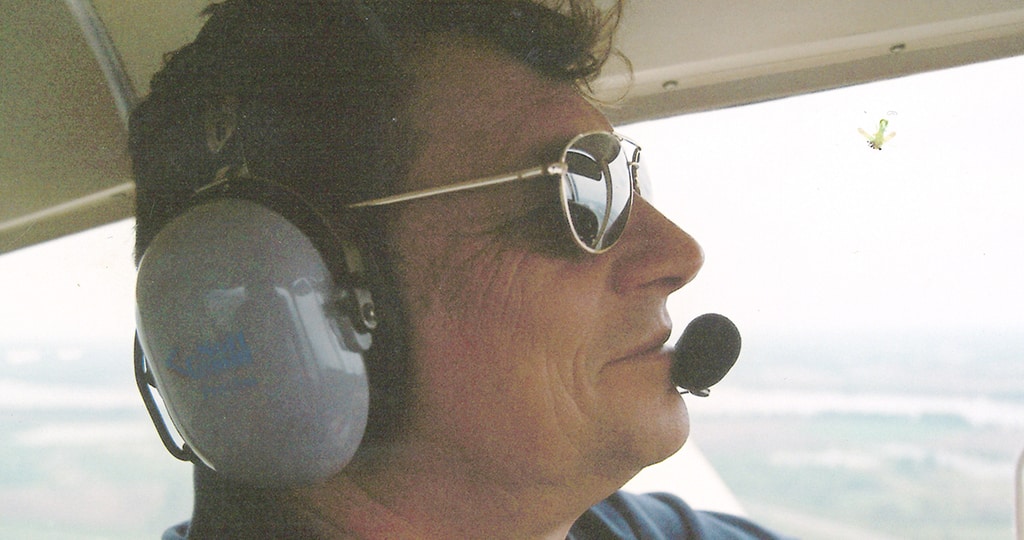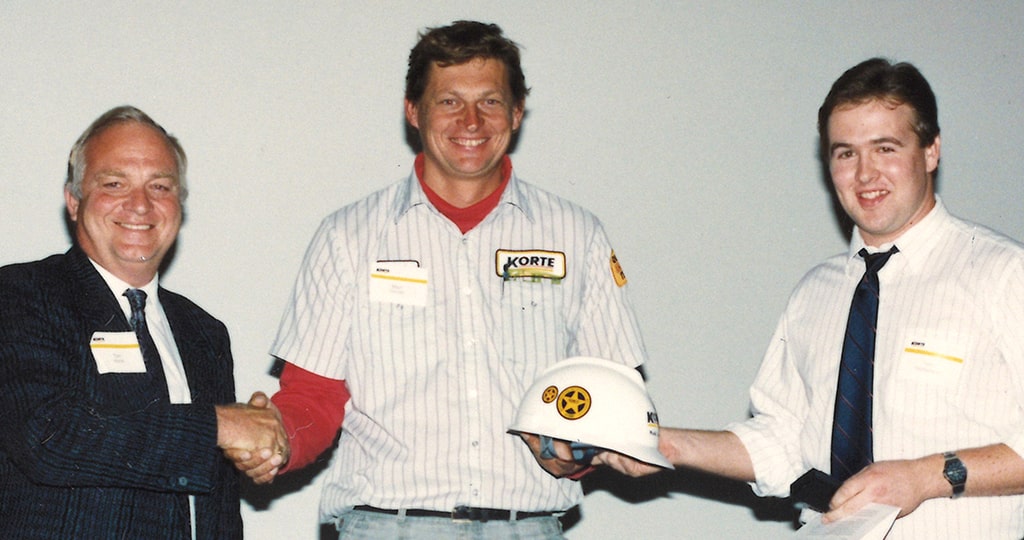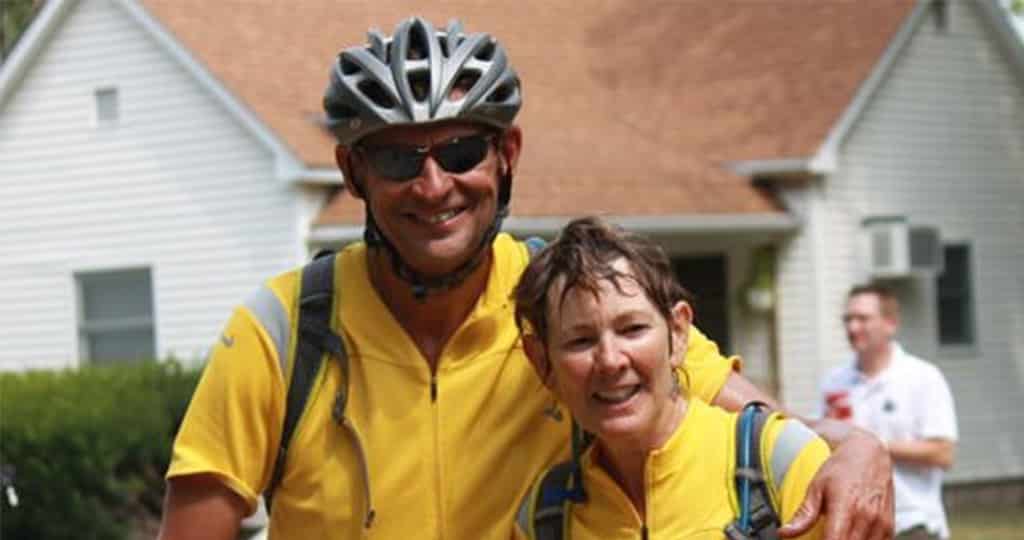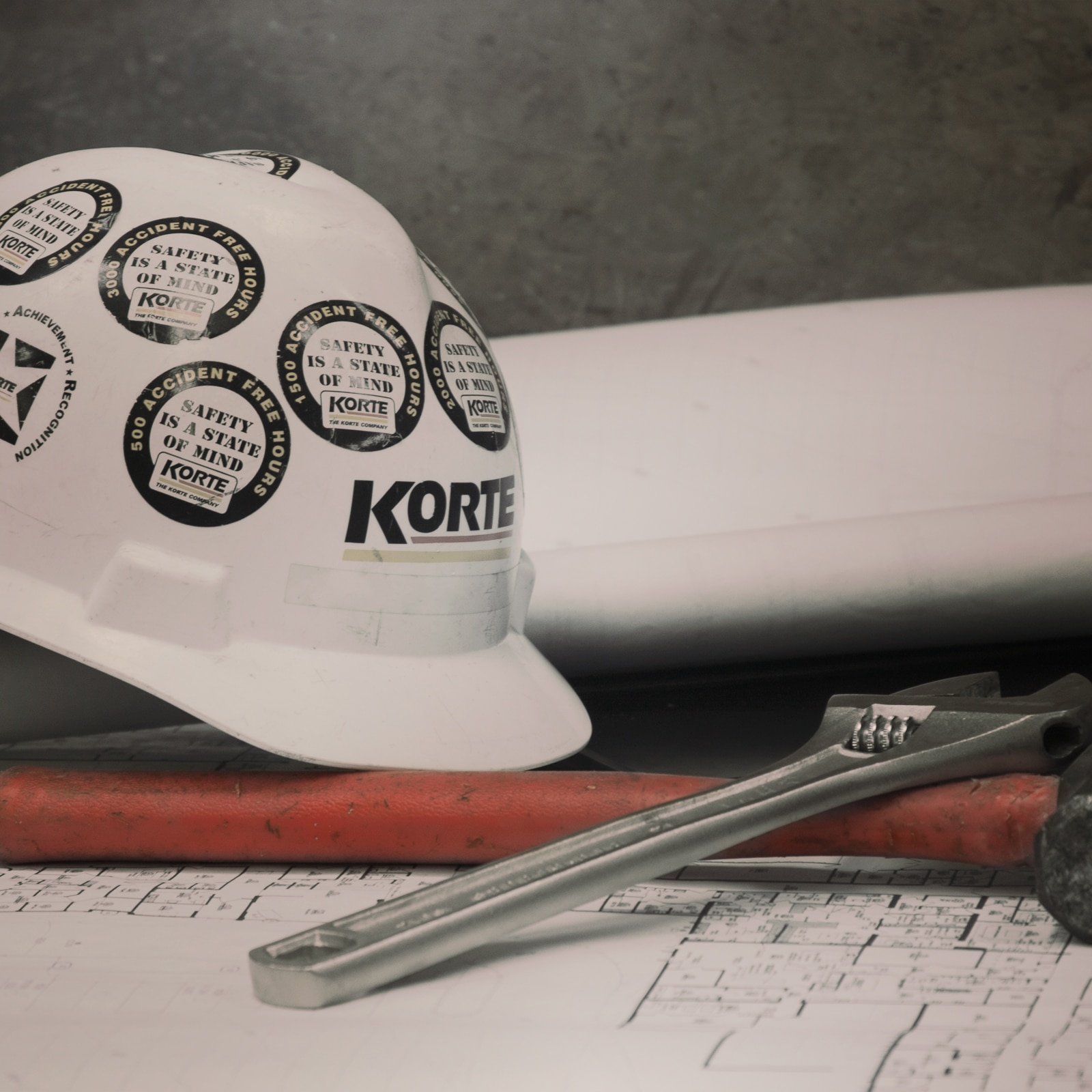Trekking his way through a jobsite, mud nearly pulling his boots off, surveyor Mark Grinter must identify a precise measurement amidst the muck. He needs accuracy—down to a hundredth of a foot. If he gets this wrong, thousands of dollars, the work of future subcontractors and frankly the whole project is at stake.
Mark skillfully carried out the demanding work of surveying, ensuring accuracy even in the face of practical difficulty—his work as Chief Surveyor, Project Manager and occasional Superintendent over 21 years with The Korte Company are evidence of that.
But Mark didn’t just accomplish these things himself. He got others to follow in his mud-caked footsteps.
They say those who can’t do, teach. But anyone who’s studied under Mark Grinter would tell you that those who have done, teach better. He pulled off a career shift from builder to educator, teaching, researching and becoming Chair of the Construction Management Department at Southern Illinois University Edwardsville (SIUE).
He showed surveying interns the ropes. He pushed his students to solve their way through real-life construction problems. He drilled the locations of anchor bolt placements into the minds of on-site crews. Wherever he went, Mark taught while doing because he taught by doing.

Dairy farm summers and college out West
Mark knew boot-muddying work since he was a kid, growing up on his parents’ farm nestled between Marine and Edwardsville, Illinois. He helped out with the mixed operation: sheep, cattle and cash crops. Starting at 14, he worked his relatives’ Madison County dairy farm alongside other kids from the area.
All in all, it was “a pretty idyllic place” to grow up.
Like anyone growing up in southern Illinois in the 1960s, Mark had heard of The Korte Company. He knew them from local projects such as the St. Clair Square Mall in Fairview Heights and heard them regularly lauded on the news as a leading local contractor. But his mind was elsewhere.
“I didn’t know the construction industry really; I was still in my scientist and engineering mode at the time. As soon as I got out of high school, I went West.”
To Prescott College in Arizona, specifically. Mark had read about the recently established university in high school and their outdoor and environmental education values stuck with him. He later transferred up to Western Washington University, another school with a strong environmental science and biology program, where he earned his degrees in Environmental Planning and Biology.
“Both at Prescott and at Western, the classes that most interested me were the field geology, field ecology, and field biology classes. And all of those are about mapping.”
His post-grad days included jobs at a logging company and the U.S. Forest Service. But after nearly eight years out West, it had come time to return home.
Right away, Mark put his degree to use. He worked for the Illinois Water Survey for five years and expanded his proficiency in field topography and hydrographic surveying. Mark then performed surveying work for Flagg and Associates in Edwardsville (one of the area’s largest engineering firms at the time) and Madison County Surveyors. He went back and forth between the two engineering enterprises, working as a Crew Chief for both.
Honing his trade at work wasn’t enough for Mark. He took the initiative to enroll in night classes through a satellite program from the Missouri University of Science and Technology, passed the surveyor exam to receive his license as a professional surveyor in 1990 and earned a graduate degree in civil engineering in 2008.
He also gained proficiency in electronic surveying instruments such as total stations and data collectors. These significantly sped up the process three, four, five times faster from tape measurements and provided greater certainty in the field.
Day in and day out, he learned and improved—and developed the skillset that would soon catch the attention of his future employer.
“After that job, I was confident”
Flagg and Associates had taken on work for the Willow Creek subdivision development in Highland, Illinois. Mark was tasked with completing the survey, a difficult job due to the site’s many curves and elevation changes as well as the street network’s challenging geometry.
Surveying requires excellent positional control, needing exact horizontal and vertical measurements down to a fraction of an inch. Otherwise, roads look crooked and subcontractors are forced to spend more money later down the line. It’s not a simple undertaking.
“You can imagine walking on a job where the mud is sucking your boots off. And you have to tell somebody within a half an inch where to put something, and you are a quarter of a mile away from the nearest known point.”
Not deterred, Mark successfully laid out all of the lots, set stakes for drains and showed the contractor exactly where everything needed to go.
“The Willow Creek job solidified my expertise and my ability to really feel competent. After that job, I was confident that no matter what, I could do the positional control on it. I didn’t care how big it was or how complicated after that job.”
Ron Hunsche, an old acquaintance from the dairy farm days, worked that subdivision project as well. At the time he was also the exclusive excavating contractor for The Korte Company. Ron saw a potential good fit for this dairy farm hired-hand turned surveying-ace.
He connected Mark with Tom Korte, the general superintendent at the time. In 1989 Mark started his career as a surveyor for The Korte Company. On his first day of work, Tom handed Mark a three-inch thick binder. He flipped it open and saw a single page hooked into the three rings with one printed statement:
Use your best judgement at all times.
“I thought, ‘Okay, I can get along with this guy.’”
“Solving problems, there’s nothing like it”
So began Mark’s career at The Korte Company, moving from jobsite to jobsite ensuring precise measurements and tight controls.
He tackled projects like the Roto-Die Company’s new world headquarters in Eureka, Missouri and the Tire Mix Building at the Continental Tire Plant in Mount Vernon, Illinois. Production facilities like these require even greater pinpoint accuracy of surveying measurements—down to a millimeter—to ensure the successful setup of industrial equipment. Mark rose to the challenge, and the manufacturers became repeat customers for plant expansions and additions.
He worked on the company’s first Walgreens distribution center in Mount Vernon in 1989, a relationship that has since gone on to include 88 projects and counting. And when a Universal Studios project posed layout problems, Mark solved them.
“It was just a complicated job with very curvilinear streets and intricate patterns in and around the pavement that had to drain properly. The subcontractor just couldn’t figure it out.”
Mark figured it out, and the job went on to win a Concrete Council Award.

As he gained experience and as the surveying team grew, Mark moved up the ranks to Chief Surveyor in 1991. These were busy times, with around 15 projects active at any one time. Mark often visited two sites a day to “communicate to the carpenter foreman what was gospel as far as positional controls.”
At the time, company crews were self-performing anchor bolt placements in the footings and foundations. And the thing about anchor bolts is, well, you can’t mark where the anchor bolt goes—it’s marked 20 feet away, and a foreman must be able to easily measure back to the correct spot.
Mark couldn’t be there every day, so communication was just as important as precision.
“It’s not just pounding stakes in the ground and walking away. You’ve got to get it in the guy’s head what this stuff means. Getting on the same page with a dozen different carpenter foremen on a dozen different jobs about how they wanted to see the control information out in the field and on the drawings; that’s where my brain was all day long every day.”
How did he feel about juggling the roving challenges of communication, controls and coordination?
“Solving problems, there’s nothing like it.”
Unique superintendent setup and $100,000 saved
The Knapheide Manufacturing Company needed to rebuild after the Great Flood of 1993 destroyed their facility on the banks of the Mississippi River. The Korte Company won the Design-Build contract for the 363,000-square-foot replacement.
Being short on superintendents at the time, Tom asked Mark to head 100-some-odd miles upriver to set up the layout and act as superintendent.
Mark wasn’t used to working as a superintendent. But he was used to doing right by the job and finding efficiencies where he could.
He changed grades to not fight the topography as much and switched to more economical flowable fill instead of “trying to go out there and beat gravel to death to get compaction.”
When it came time to decide on materials for storm sewers, the case for high density polyethylene pipe (HDPP) was clear as day to Mark. HDPP cost less, lasted longer and weighed less (making for a safer install) compared to concrete pipes. He pushed hard for these cost- and time-saving measures.
“I’d come up against these engineers and their answer was, ‘We’re used to it. We always have. And the concrete industry wants us to.’ That’s baloney. Here’s the research that shows this is a better product. Now tell me why, as an engineer, you don’t follow the research instead of doing it the way you did yesterday.”
When all was said and done, they saved $100,000 on the job.
“And Tom says, ‘You know what? If you can save me that much money, let’s keep doing this.’”
From 1995 to 2006, Mark continued this role as a sort of “pre-superintendent” from the day the project started until the footings were poured. He additionally moved into a Project Manager position at the end of 2005.
This was an unorthodox setup in the industry. But to us, it made sense. After all, The Job is The Boss.
“If you’ve got any knowledge, try to share it”
During Mark’s early days as a surveyor for The Korte Company, Tom regularly found interns to assist him with field work. From his first intern, Shad James, “a crackerjack kid from up in White Hall, Illinois,” the extra set of hands was a big help to Mark.
“He just kept sending me one after another. And I said, ‘Tom, can’t you just get me one guy and let me keep a good one?’ He said, ‘No. You need to train these guys. This is your job.’”
Tom kept sending interns (including one from Scotland), and Mark kept training them. He took them through every step in his work, clearly explaining what he was doing and why, then letting them try their hand at collecting data and populating AutoCAD drawings themselves.
Mark’s interns back then included Mike Marchal, John Hooker, Suzanne Pohlman and Brent Korte—more on them in a minute.
Fast forward to the late 1990s when another teaching opportunity presented itself. This time, in the format of a guest lecture on bench marks for a SIUE surveying course.
Right away, the feedback from students was positive, the chief compliment being, “This guy knows what he’s talking about.” Mark took over the once-a-year course, teaching nights for the next few years while still putting in the full 40-plus hours at The Korte Company.
Luke Snell, the head of the Construction Management Department regularly told Mark he should come on board and teach full-time. But deciding whether to leave his career to become a professor wasn’t easy.
“I’d be in this completely new environment. But I said, ‘You know what? You need a new environment. You’ve been doing this for 21 years—it’s time to share. If you’ve got any knowledge, try to share it. And try something different.’”
And so Mark began his second career in 2010 as a full time professor in the Construction Management Department of SIUE’s School of Engineering. He taught upper division courses in project management, plans and specifications, land development and heavy civil construction and eventually rose to Department Chair.
Lectures in Mark’s classroom consisted of the students presenting on change orders and liquidated damages. Internships approved by Mark (he was in charge of all the documentation) weren’t just gigs sweeping the warehouse floor, but ventures in gaining construction knowledge and building industry relationships.
He found it especially rewarding to push students whose natural inclination may not be to network and make presentations, but who he could tell had talent and drive. Megan Banks was one of those students.
“I sat in on a class where she did a presentation. She kind of struggled but I could tell she could connect with people. When Megan presented on a topic she knew something about, she did a great job. And I went up to her afterwards and I said, ‘You were a standout in this class. You’ve really got to stick with this.’”
She did. Most recently, Megan worked as an assistant project manager at S.M. Wilson & Co., a multi-million dollar construction management firm. In 2017, the St. Louis Business Journal included her in their annual 30 Under 30.
Reflecting on his past interns and students, a common thread remains clear.
“Almost every one of them remarked to me, ‘Well, I actually learned something working with you,’ because I had them actually perform the task.”
And as for his original surveying interns and other former students? Their titles now include:
Shad James, President of Jaynes Corporation Construction.
Mike Marchal, President of Holland Construction.
John Hooker, President and Owner of JHOOKER Construction Services.
Suzanne Pohlman, senior Project Manager at AMEREN Corporation.
Kort Cole, Project Director at Clayco.
Rob Johnes, President at Helmkamp Construction.
Ryan Poettker, Executive VP and Chief Operations Officer at Poettker Construction.
Keith Poettker, President at Poettker Construction.
Brent Korte, current Chief Operating Officer for The Korte Company.
Trading surveying wheels for bike wheels
Looking back on his 21 years with The Korte Company, Mark felt that he worked with, rather than for, them. Those seven words inside the binder from his first day rang true across two decades worth of projects.
“The idea that the job is the boss was the overwhelming thing to me. What do we need to do to make the project go? That was the question that you could always ask yourself. And then, use your best judgment to answer that. I liked the ability to be innovative, use your best judgment and not just be a wheel in a cog.”
The Grinter legacy at The Korte Company carries on with Mark’s oldest son, Caleb. He spent time out West (just like his father) where he guided rafting expeditions in Colorado, earned his law degree at Denver University and worked for a federal judge. Today Caleb is on and off the road accomplishing QC tasks on jobsites. He also pilots the company drone, showcasing sweeping aerial imagery from before and after projects.
“He’s done some pretty impressive videos. I’m proud of him and happy for him.”

Today, Mark works his 380-acre farm north of Highland and keeps up with his wife Linda on their bike trips across the Midwest. The couple bought a tandem bike years ago, where it got about a whopping five uses—two kids, two jobs and a farm prevented any ambitious treks.
But a dispatch out to South Carolina jump started a competitive streak between the couple. Mark brought along an old bike to have something to do in his free time. Back home in Illinois, Linda did the same, logging 18 miles one day. Another day, 36 miles.
“She’s built up all these miles while I’m gone. I’m like, ‘I better hammer it out to be able to keep up with her.’ So, when I got back home, we said, ‘You know, we ought to get that tandem out again.’ And we did. And we just loved it.”
That first year the couple logged 2,000 miles and started a tradition of completing multi-day trips together. Since then they’ve ridden across Iowa a few times, Nebraska six times and all over Illinois.
“Rolling the Sandhills of Nebraska, topping 12,000 feet in elevation at Independence Pass in the Rockies and sunrise rides across the Illinois prairie stand out as ‘wow’ factor rides. Riding low-traffic highways and back roads at cycling speed allows a connection with the locale like no other.”
Memories of surveying and teaching successes still stick with him. The joy of working on the NASA Project Engineering Facility (as a boy who had excitedly watched Project Mercury and Project Gemini launches). The challenge of engineering banked curves at the Gateway International Raceway. Playing a part in educating the future leaders of construction companies across the country.
But that’s in the rearview mirror now—and up ahead stretch hundreds of miles of trails.
“When you’re on the bike, life is just good.”
